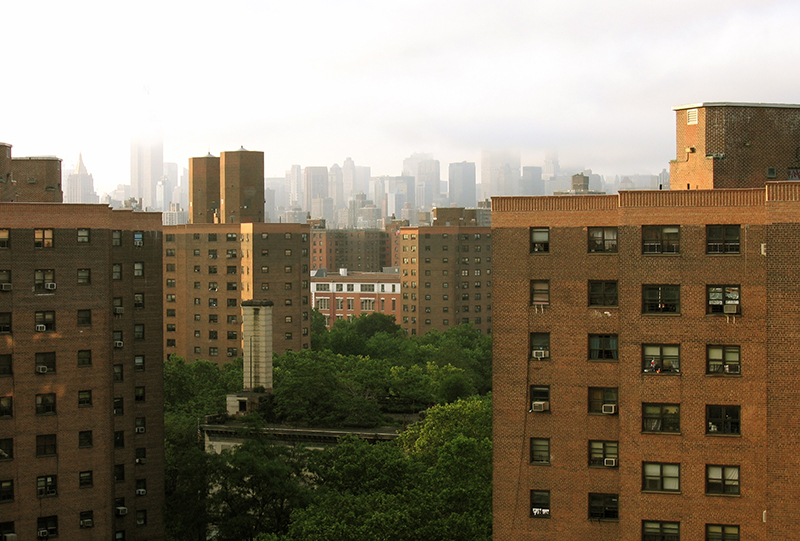Towering over Manhattan’s Inwood neighborhood, New York City Housing Authority’s Dyckman Houses are not what people typically associate with high-rise living—yet the seven fourteen-story towers provide affordable homes for thousands of New Yorkers. The Dyckman Houses are also surrounded by the largest concentration of rent-regulated private housing stock left in New York City. Together, these structures have come to symbolize the last stronghold of twentieth-century affordable housing strategies in an increasingly unaffordable city.
In recent decades, the kinds of public and regulated housing models that proliferated in Inwood during the mid-century have been characterized by both landlords and politicians as out of touch with the realities of the country’s private housing system. Tenants, though, have tenaciously defended these buildings and what they represent, fighting for increased protections, the renewal of rent laws, and increased building management. This organizing has recently resulted in a political watershed for tenants in private, rent-regulated housing. This past April, the New York legislature passed “Universal Rent Control” in the state, indefinitely extending rent regulations and strengthening protections for tenants. The politics of rent regulation seem more hopeful for tenants than they have been in several decades.
But at the same time, New York City’s public housing system faces $32 billion in deferred maintenance. For example, the Dyckman Houses complex has violations that range from broken elevators and crumbling walls to failed heating systems. The housing authority was placed under formal federal oversight by Department of Housing secretary Ben Carson in January 2019, and at the moment the agency’s fate remains unclear. This is no small matter: as the largest public housing authority in the country, its fate will impact more than 400,000 people, nearly a tenth of renters in New York City.
New York’s struggle to adequately finance its public housing represents a broader trend toward privatizing public goods in cities throughout the country. Since the 1970s, conservative and liberal politicians alike have advocated for the private management of municipal provisions in service of cost efficiency. The adage to run the country “like a business” has led cities to privatize housing, education, hospital services, elder care, and transportation, as well as essential services such as water and waste removal. The high cost of these privately managed municipal contracts belies the logic that privatization saves money. Instead, private contracts make public accountability diffuse, leaving residents without a specific agency, politician, or group that must answer their complaints.
One of the most praiseworthy qualities of public housing is that because the state is the landlord, residents have two avenues for addressing grievances: as tenants and as citizens. The state’s efforts to phase out true public housing—mainly by shifting public housing residents to a private voucher system—is consistent with a broader pattern that champions the purported benevolence of the marketplace while offloading state responsibilities onto private citizens. In the face of the Trump administration’s undermining of the housing authority, New York should vow to provide more rather than less public housing. Keeping the “public” in public housing would make good on the social democratic promise of the city’s unique, large-scale endeavors in human shelter while creating radical possibilities for what these towers could symbolize in a city where deep economic inequality remains a principal marker.
• • •
The experience of inhabiting municipally managed residential towers or rent controlled housing was common in the mid-century. Faced with skyrocketing rents and housing shortages after World War II, federal housing administrators leveraged rent controls on private landlords as an emergency measure to house people in cities. Building new housing for urban dwellers became a major priority of postwar demobilization, and many cities took full advantage of the significant funding for public housing construction galvanized by the Federal Housing Act of 1949.
By the mid-1950s, New York, which never fully repealed wartime rent regulations, erected dozens of what architect Mabel O. Wilson calls “modernist architectural experiments in verticality,” in part to house a growing population of returning soldiers and their families. In Chicago, the Cabrini-Green Homes captured the hopes of African American tenants when the brick mid- and high rises were completed in the late 1950s. St. Louis’s Pruitt–Igoe Apartments likewise offered improved shelter for black families previously relegated to the city’s so-called “slums” when it was completed in 1955. And in 1966 New Orleans completed its thirteen-story Fischer housing development for the elderly.
In many cities, public housing developments became central to an emerging debate around how city blocks should be planned and constructed—with neighborhood activists mourning the inevitable change and loss of an “eyes on the street” community. Nonetheless, the superblock structures housed more tenants than previous tenement housing and made a bold and tacit statement about what a local government was willing to offer its residents: quality shelter with access to light, greenery, and community spaces.
In the decades that followed, these towers became associated with crime, delinquency, and entrenched poverty. Chronic underinvestment, a by-product of the hollowing out of the urban tax base via white flight in the postwar decades, left many of these buildings in almost bombed-out disrepair, symbols of urban decay for the suburban technocrat. By the 1980s, many were demolished by local governments, and the few that remained seen as hopelessly out of step with the latest ideologies of what public housing should look like.
While cities made promises to relocate residents of these buildings to modern, scatter-site affordable housing, the majority of tenants remained displaced by long wait times and new eligibility standards that required participation in job programs, drug testing, and other forms of surveillance. The decline of large-scale public housing came to be a metaphor for what the proper role of government should be in the lives of the poor, consistent with an era of welfare retrenchment, means testing, and workfare programs.
• • •
Remarkably, New York City public housing structures largely escaped formal decommissioning and demolition. Still, they remained relics of a different housing paradigm. In the 1970s, sections of the Bronx’s poorest neighborhoods burned down from arsons that city officials took little interest in preventing, solving, or prosecuting. Meanwhile, politicians aggressively chipped away at rent regulations through vacancy and luxury decontrol legislation.
In the place of public housing, politicians championed a patchwork of subsidies and market-based solutions. These included, most notably, transitioning public housing residents to Section 8 vouchers, which provide recipients with rent subsidies on the open rental market. Meanwhile, a vocal real estate lobby decried tenant protections as hostile to development, and legislatures in New York and beyond passed significant tax incentives for development while making it easier for landlords to evict tenants they no longer wanted.
While the recent win for tenants in the New York Senate promises to stem this tide of deregulation, the New York Times reports that the city has lost about 300,000 units of affordable housing since 1993. And none of these reforms even attempt to address the fact that so much public money marked for poverty assistance simply ends up funding for-profit luxury building. The perversity of the incentives and loopholes available to real estate developers was recently highlighted when CityLab revealed that the Hudson Yards project raised at least $1.2 billion of its funding through a scam. Developers gerrymandered their luxury project into a designated “distressed urban area” that included a low-income housing project in Harlem, a hundred blocks away. This way Hudson Yards could attract foreign investors who wanted a U.S. residency visa, which they could get through a pay-to-play scheme in which visas are granted for $500,000 investments in low-employment areas.
Just who is to blame for the very real problems within the NYCHA is an open question. City administrators have cited repeated budget cuts and divestment from the U.S. Department of Housing and Urban Development (HUD), while the newly appointed HUD administrator for New York and New Jersey, Lynne Patton, has blamed unions. The January 2019 decision to place NYCHA under federal oversight has been met with mixed feelings: while some residents are hopeful that the decision might bring long-overdue repair to buildings, others—almost certainly correctly—believe that the Trump administration is more interested in undermining faith in public goods than in assisting the poor.
Unsurprisingly, HUD’s proposed solution to NYCHA’s woes is to privatize the system. A recent report indicated that part of the plan of Carson-appointed federal monitor Barry Schwartz is to convert residents’ Section 9 leases (public housing) to Section 8 vouchers, promising access to new, privately managed buildings in exchange. But unlike NYCHA, new Section 8 leases would be administered by private landlords, and even more subject to the federal government’s funding fluctuations. Under the direction of Schwartz, NYCHA representatives have begun meeting with public housing residents to exhort them to take this deal—but at least some residents report that the differences between the leases has never been adequately explained to them.
In large part, HUD administrators have found allies for these plans in the De Blasio administration, which appears eager to resolve the scandals that have followed the agency. However, while NYCHA apartments require significant renovations and updates, they boast a key feature that Section 8 buildings lack: the city of New York is the landlord. NYCHA residents are not just tenants, but also constituents. Under a system of truly “public” housing, the public wields the ability to hold administrators accountable through various forms of public accountability, voting not least of all. Under a voucher system, the city would be paying private landlords to house tenants—a wealth transfer that directly benefits the landlords while leaving tenants with weakened protections.
Like rent-regulated leases, Section 8 leases are underwritten by a state-backed promise to keep landlords nominally accountable. However, even with these protections in place, poor tenants nationwide face an uphill battle finding landlords willing to accept their vouchers. They also have little recourse if a landlord chooses to sell their building or remove it from the federal program. In other words, while a voucher may technically entitle a tenant to housing subsidized by the state—whose whims fluctuate according to administration—it is no guarantee of a stable, habitable home.
It is also true that merely having the city as a landlord has often left NYCHA residents stranded without heat in the winter or in crumbling units year round. Public ownership alone does not guarantee public accountability. What is different under the current, flawed, municipal management of city resources is that NYCHA tenants are better equipped to do what public housing tenants have been doing for decades: organize. With one agency rather than myriad private landlords to hold to account for these issues, tenants retain their communities, and stand a chance of assembling the kinds of alliances that might move the city towards equitable policies. As historians Rhonda Williams, Lisa Levenstein, and Annelise Orleck have demonstrated, public housing was never a system bestowed upon the impoverished by administrators, but rather an arrangement that was fought for through decades of organizing by poor black women and cross-ethnic coalitions.
Ultimately, New York’s housing projects are the only thing that stands between thousands of residents and banishment from their neighborhoods. Rents surrounding the Dyckman Houses, for instance, have risen dramatically since the new millennium. According to the NYU Furman Center, the median rent in the neighborhood was roughly $940 in 2000. By 2017 the median ballooned to roughly $2,090. For an area whose residents are severely rent-burdened (spending more than 50 percent of household income on rent), the closest comparable rent would require them to travel deep into other boroughs or leave New York City altogether.
New York should not pull away from its commitment to the public housing towers that made the city a pioneer of low-cost dwellings during the postwar period. On the contrary, it should reinvest in their significance. This would turn the tide on what has been, in recent years, the city’s lackadaisical approach to its housing crisis. Under pressure from residents and activists, city officials should recommit to the social promise that these high rises, imperfect as they were, symbolized when first built: decent shelter should be available to everyone. Then, maybe, we can lift the ideological baggage that public housing has carried in U.S. popular culture. The towers may yet become symbols of belonging, racial justice, and a working-class right to live in cities.






